How well do you know the Code? Think you can spot violations the original installer either ignored or couldn't identify? Here's your chance to moonlight as an electrical inspector and second-guess someone else's work from the safety of your living room or office. It's your turn to identify the violation.
Hint: Creative combo
Find the Answer
It looks as though this installer couldn't decide between metal or plastic, so he decided to use both. Unfortunately, this creative combination created a few NEC violations.
AC cable must be mechanically secured to the box in accordance with 300.10 and supported within 12 in. of the box as per 320.30(B). This AC cable is simply stuffed into a box opening without a connector or clamp.
Grounding type receptacles are required to be connected to an equipment grounding conductor in accordance with 406.4(C). AC cable armor is permitted as an equipment grounding conductor in accordance with 250.118(8), however, since a plastic box was used with this AC cable, there is simply no way to establish a connection from the grounded cable armor to the equipment grounding terminal of the receptacle.
Receptacles must be mounted to a box in accordance with 406.5. This floating, ungrounded receptacle can pose a real shock hazard to anyone attempting to plug a cord into it.
AC cable secured to a metal box, and a securely installed and properly grounded receptacle and plate would make for a much safer installation.





